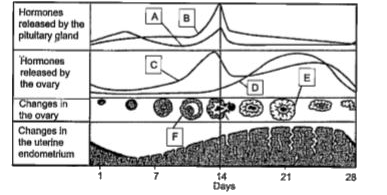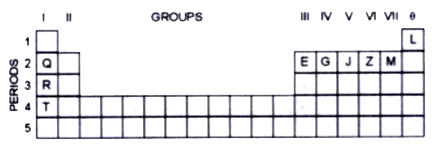Study the extract of the Periodic Table given below and answer the questions. Give the alphabet corresponding to the element in question. Do not repeat an element. State which element: Forms an electrovalent compound with G.
To solve the question, we need to identify which element forms an electrovalent compound with element G from the provided periodic table extract. Let's break down the steps:
Step 1: Identify the Element G
From the video transcript, we learn that element G corresponds to chlorine (Cl), which is a non-metal located in Group 7 of the periodic table.
Step 2: Understand Electrovalent Compounds
Electrovalent compounds, also known as ionic compounds, are formed between metals and non-metals. In these compounds, metals lose electrons to become positively charged ions (cations), while non-metals gain electrons to become negatively charged ions (anions).
Step 3: Identify Potential Metal Elements
We need to look for a metal element from the periodic table that can form an ionic bond with chlorine (G). The video mentions that element B is a metal from Group 2, which is likely to be magnesium (Mg).
Step 4: Forming the Electrovalent Compound
Magnesium (Mg) can lose two electrons to form Mg²⁺ ions. Chlorine (Cl), being a non-metal, can gain one electron to form Cl⁻ ions. Therefore, when magnesium reacts with chlorine, it forms the electrovalent compound magnesium chloride (MgCl₂).
Step 5: Conclusion
Thus, the element that forms an electrovalent compound with G (chlorine) is B (magnesium).
Final Answer
The element that forms an electrovalent compound with G is B (Magnesium).
---
From the video transcript, we learn that element G corresponds to chlorine (Cl), which is a non-metal located in Group 7 of the periodic table.
Electrovalent compounds, also known as ionic compounds, are formed between metals and non-metals. In these compounds, metals lose electrons to become positively charged ions (cations), while non-metals gain electrons to become negatively charged ions (anions).
We need to look for a metal element from the periodic table that can form an ionic bond with chlorine (G). The video mentions that element B is a metal from Group 2, which is likely to be magnesium (Mg).
Magnesium (Mg) can lose two electrons to form Mg²⁺ ions. Chlorine (Cl), being a non-metal, can gain one electron to form Cl⁻ ions. Therefore, when magnesium reacts with chlorine, it forms the electrovalent compound magnesium chloride (MgCl₂).
Thus, the element that forms an electrovalent compound with G (chlorine) is B (magnesium).
The element that forms an electrovalent compound with G is B (Magnesium).
Topper's Solved these Questions
- PERIODIC TABLE (PERIODIC PROPERTIES AND VARIATION OF PROPERTIES)BOOK - ICSECHAPTER - PERIODIC TABLE (PERIODIC PROPERTIES AND VARIATION OF PROPERTIES)EXERCISE - ADDITIONAL QUESTIONS
74 Videos
- PERIODIC TABLE (PERIODIC PROPERTIES AND VARIATION OF PROPERTIES)BOOK - ICSECHAPTER - PERIODIC TABLE (PERIODIC PROPERTIES AND VARIATION OF PROPERTIES)EXERCISE - ADDITIONAL QUESTIONS (Fill in the blanks with the appropriate word/s in each case.)
24 Videos
- PERIODIC PROPERTIES AND VARIATIONS OF PROPERTIESBOOK - ICSECHAPTER - PERIODIC PROPERTIES AND VARIATIONS OF PROPERTIESEXERCISE - ASSERTION AND REASON BASED QUESTIONS
5 Videos
- PRACTICAL CHEMISTRY BOOK - ICSECHAPTER - PRACTICAL CHEMISTRY EXERCISE - Questions from Previous ICSE Board Papers (2017)
2 Videos
Similar Questions
Study the extract of the Periodic Table given below and answer the questions. Give the alphabet corresponding to the element in question. Do not repeat an element. State which element: Is an inert gas. State the ion of which element will migrate:Towards the cathode during electrolysis
View SolutionStudy the extract of the Periodic Table given below and answer the questions. Give the alphabet corresponding to the element in question. Do not repeat an element. State which element: Is non-metallic and has a valency of 2.
View Solution
Knowledge Check
Study the table given below and answer the following questions :

Which is the hottest month?AJuneBMayCJulyDAprilStudy the diagram given below and answer the questions that follow:

The alphabet 'A' represents ______ hormone.AOestrogenBProgesteroneCFSHDLHStudy the table given below and answer the following questions :

Which part of India do you think the given place is located in?AInterior parts of Northern IndiaBWestern coast of IndiaCEastern coast of IndiaDInterior parts of Peninsvlar India
Study the extract of the Periodic Table given below and answer the questions that follow. Give the alphabet corresponding to the elements in question. DO NOT repeat an element.

Which is an inert gas ?
View SolutionUse the letters only written in the Periodic Table given below to answer the questions that follow :

Which metallic element is more reactive than R?
View SolutionUse the letters only written in the Periodic Table given below to answer the questions that follow :

Which element shown forms ions with a single negative charge ?
View SolutionUse the letters only written in the Periodic Table given below to answer the questions that follow :

Which element has its electrons arranged in four shells ?
View SolutionWhich of the following elements has the strongest tendency to form electrovalent compound ?
View Solution
